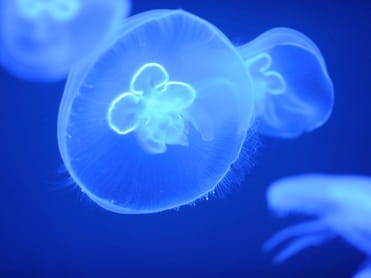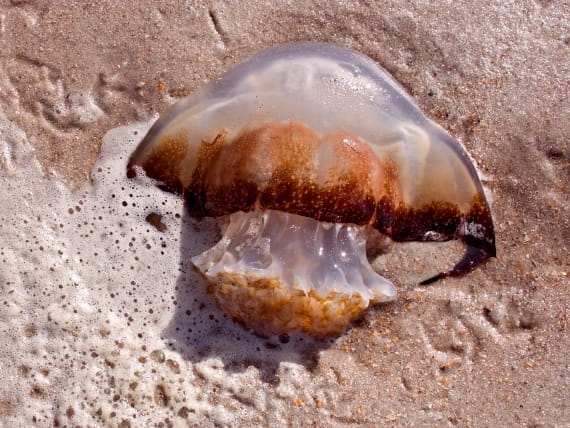Jellyfish: A Pain at the Beach

The Bottom Line
Jellyfish swim in waters off beaches and so pose a risk to human swimmers. When their tentacles touch skin, they pierce the skin and release a pain-causing substance. Treatment involves removing the tentacles and stopping the pain; both can be hard to do! Allergic reactions are possible, too.

The Full Story
Jellyfish or sea nettles are found in waters off beaches around the world. While they are beautiful swimmers, an encounter with one can certainly interrupt a beautiful day. To avoid problems, stay out of the water when jellyfish are known to be numerous in a particular area. Also, do not pick up jellyfish or jellyfish parts from the beach. Even dead jellyfish can give nasty sting, causing pain and a rash at the site of contact.
Jellyfish protect themselves with nematocysts on their tentacles. When these make contact with human skin, a small sharp harpoon-like structure pierces the skin and deposits venom. The pain of a jellyfish sting is really in two parts: a skin puncture and a pain-inducing substance in the puncture wound.
Ideally, treating a jellyfish sting would involve two things: inactivating the venom and removing the tentacles. Unfortunately, no one substance counteracts every type of jellyfish sting. For example, vinegar helps for some jellyfish stings, but makes others worse. Also, more than one type of jellyfish may be found in a given area.
If you are stung by a jellyfish, here are some first aid steps:
- Rinse the area with plenty of sea water. Do NOT use fresh water. Avoid vinegar, ammonia, alcohol, or other liquids unless you know what type of jellyfish it was and the best treatment for that particular type.
- Remove any remaining tentacles.
- Protect your hands while doing this by using tweezers, heavy gloves, or a towel.
- Then, apply shaving cream or a paste of baking soda and water. Shave with a razor or the edge of a credit card.
- Treat pain with an over-the-counter pain reliever. If pain is severe, see a doctor for more effective relief.
- Treat itching with an over-the-counter anti-itch cream and/or an antihistamine, such as diphenhydramine (Benadryl®). If itching is severe, see a doctor for a stronger preparation.
- See a doctor if someone is stung in the mouth, in or near the eye, on a large area of skin, or on the genital region.
If the person has trouble breathing, starts wheezing, or develops hives or welts on other body parts, it could be an allergic reaction. This is a medical emergency; call 911 immediately. Also call 911 if the person develops chest pain.
Keep the Poison Control phone number with you, even at the beach. Call 1-800-222-1222 to reach a local expert if you are stung by a jellyfish or have any other kind of poisoning problem. The number works from every state in the U.S.
Rose Ann Gould Soloway, RN, BSN, MSEd, DABAT emerita
Clinical Toxicologist
Poisoned?
Call 1-800-222-1222 or
Prevention Tips
- Stay out of the water when jellyfish are known to be numerous in a particular area.
- Do not pick up jellyfish or jellyfish parts from the beach.
This Really Happened
A 39-year-old woman was swimming in the Atlantic Ocean while on vacation in August. When she emerged from the water she had many red, painful welts on her legs that appeared to be from jellyfish. She did not see any embedded tentacles. She applied vinegar and diphenhydramine [Benadryl®] cream to the areas but was still in significant pain. She called Poison Control 6 hours after being stung. She was advised to bathe the areas in salt water, not fresh water. (Fresh water may discharge nematocysts, cells found in jellyfish tentacles that contain hollow coiled tubes with toxic barbs that deliver a sting.) Poison Control also recommended that she try oral diphenhydramine and topical hydrocortisone cream and that she be medically evaluated at an urgent care center; she was having so much pain and she needed a tetanus booster shot.
During a follow-up call from Poison Control the next day, the patient reported that she didn't get seen at urgent care but was doing better. She had applied hydrocortisone cream to the affected areas and was having only some itching.
Two days after the stings, the patient reported during a follow-up call from Poison Control that the itching and redness had resolved and that she would check with her primary physician about getting a tetanus booster.
Poison Control was next consulted about the patient by an emergency physician 6 days after being stung. She reported a flare-up of her initial symptoms: pain, itching and a rash despite taking antihistamines, though the emergency physician believed she wasn't taking adequate amounts. Poison Control recommended application of hydrocortisone cream, a topical anesthetic, therapeutic doses of diphenhydramine, pain medication and tetanus immunization.
Eight days after the exposure, the patient told Poison Control that she was doing better and was taking antihistamines. Two weeks after being stung, her symptoms were resolving and she was feeling much better.
For More Information
Photos and information about jellyfish (Smithsonian Institution National Museum of Natural History)
References
Ward NT, Darracq MA, Tomaszewski C, Clark RF. Evidence-based treatment of jellyfish stings in North American and Hawaii. Ann Emerg Med. 2012;60:399-414. http://dx.doi.org/10.1016/j.annemergmed.2012.04.010
Poisoned?
Call 1-800-222-1222 or
Prevention Tips
- Stay out of the water when jellyfish are known to be numerous in a particular area.
- Do not pick up jellyfish or jellyfish parts from the beach.
This Really Happened
A 39-year-old woman was swimming in the Atlantic Ocean while on vacation in August. When she emerged from the water she had many red, painful welts on her legs that appeared to be from jellyfish. She did not see any embedded tentacles. She applied vinegar and diphenhydramine [Benadryl®] cream to the areas but was still in significant pain. She called Poison Control 6 hours after being stung. She was advised to bathe the areas in salt water, not fresh water. (Fresh water may discharge nematocysts, cells found in jellyfish tentacles that contain hollow coiled tubes with toxic barbs that deliver a sting.) Poison Control also recommended that she try oral diphenhydramine and topical hydrocortisone cream and that she be medically evaluated at an urgent care center; she was having so much pain and she needed a tetanus booster shot.
During a follow-up call from Poison Control the next day, the patient reported that she didn't get seen at urgent care but was doing better. She had applied hydrocortisone cream to the affected areas and was having only some itching.
Two days after the stings, the patient reported during a follow-up call from Poison Control that the itching and redness had resolved and that she would check with her primary physician about getting a tetanus booster.
Poison Control was next consulted about the patient by an emergency physician 6 days after being stung. She reported a flare-up of her initial symptoms: pain, itching and a rash despite taking antihistamines, though the emergency physician believed she wasn't taking adequate amounts. Poison Control recommended application of hydrocortisone cream, a topical anesthetic, therapeutic doses of diphenhydramine, pain medication and tetanus immunization.
Eight days after the exposure, the patient told Poison Control that she was doing better and was taking antihistamines. Two weeks after being stung, her symptoms were resolving and she was feeling much better.
